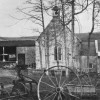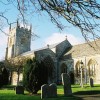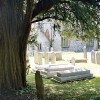On the 14th of August 1739 a charter incorporating the Hospital for the “Maintenance and Education of Exposed and Deserted Young Children” was signed by King George II. This was the culmination of seventeen years of determined campaigning by Thomas Coram, who was concerned about the number of abandoned and dying children on the streets of the capital. On a bleak November day in the same year in a room at Somerset House, London, the Governors of the Foundling Hospital convened for their first meeting.
We have to search his later correspondence for glimpses into the early years of Thomas Coram. He was born in Lyme Regis and we believe he was the son of John Coram who was in the merchant shipping business and traded from Lyme Regis. John Coram was baptised in 1629; his wife, Spes, died in 1677. Thomas wrote that his mother had died when he was a young boy; his father had remarried and moved to Hackney. Thomas went to sea when he was eleven and later his father apprenticed him to a shipwright.
At the age of 24 he was appointed by the government to audit tonnage and supply transports for Ireland and this brought him to the attention of some London merchants, who put him in charge of a plan to establish a new shipyard in Boston, Massachusetts. The colony was Puritan and Coram was an Anglican; he acquired enemies and an attempt was made on his life during the ten years he was there. He married Eunice Wayte on the 27th of June 1700. Correspondence with his wife’s family suggests it was a happy marriage but childless.
Coram returned to England in 1704. His interest in the North American colonies led him to identify Boston’s need for a lighthouse and fraud in contracting navel stores from there. In 1712 he was elected to a role in the private enterprise, Trinity House, which combined public responsibilities with charitable works. He was considered a diligent and reliable public servant as well as a businessman. In 1735 Horace Walpole told his brother Robert, then Prime Minister, that Coram was the “honestest, the most disinterested and the most knowing person about the plantations I ever talked with.”
In England he pursued his business and charitable interests from his home at Rotherhithe. He regularly travelled into the city and on those journeys he saw abandoned, dying and dead children on the streets. In 1722 his moral and civic spirit compelled him to take action.
He had a wealth of experience and many acquaintances, some of them with great influence while he had persistence; against him was his rough-manner and rather blunt way of speaking. Initially there was little interest in his attempts to promote a foundling hospital – indeed, some were positively hostile to the idea on the grounds that it would encourage more illegitimate births.
The situation improved in 1729 with the ‘ladies petition,’ which was signed by peeresses and had the patronage of Queen Caroline, but it took until the 21st of July 1737 for Coram’s petitions to be laid before the king in council. A committee of the Privy Council was set up to consider the proposal, while Coram was given the responsibility for finding the first governors.
It was Coram who looked for suitable sites for the hospital, designed its seal and researched similar institutions in Europe. The hospital opened on the 25th of March 1741 at a site in Hatton Garden. The first two children to be baptised were named Thomas Coram and Eunice Coram (it was usual for children to be given a new name when they entered the hospital). Mothers left a token to identify their child should they wish to claim them later.
Coram’s involvement in the governance of the hospital ended in 1742 under a cloud: he was said to have been indiscreet in his criticisms of other Governors and how the hospital was run. A new hospital was built at Lamb’s Conduit Fields and began to receive children in October of 1745. The hospital continued into the 20th century, moving out of London to Berkhamstead in Berkshire in 1926; it finally closed as a hospital in 1954. Over the centuries the institution cared for over 25,000 children; the ideals and work continue to this day as the children’s charity known appropriately as “Coram”.
The Foundling Hospital prospered and surprisingly became a meeting place for fashionable society, who by then supported the project. People came to admire works of art donated by prominent artists such as William Hogarth, Francis Hayman and Joseph Highmore; George Frederic Handel organised annual concerts at the hospital from 1750.
Thomas Coram’s career had been at the sharp-end of life. Hands-on, dealing mostly with ordinary men, he was not equipped with the airs and graces necessary to mix easily with London society in the 18th century; his bluntness and straight-forward speaking did not sit comfortably with those he wished to gain influence with. Nevertheless, his achievements were significant: Boston harbour had a new lighthouse, the Georgia trustees permitted female inheritance, and a civil settlement was established in Nova Scotia. All these things Coram had campaigned for.
In his good works he often used his own resources, with little thought for his own needs. He was not ashamed to admit “in my old age, I am poor.” However, his friends and supporters raised a pension to see him through his last years free from want.



